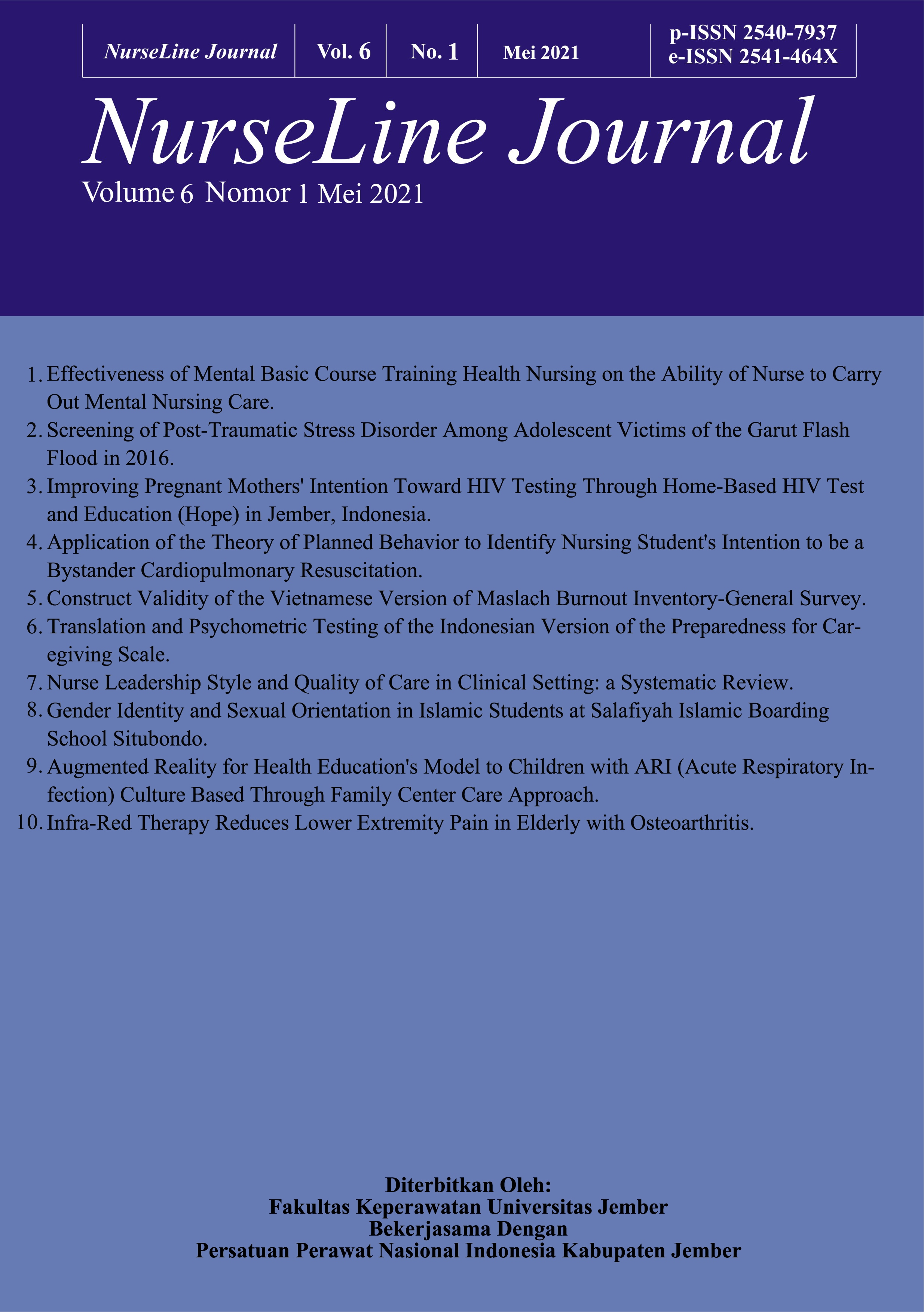Augmented Reality for Health Education's Model to Children with ARI (Acute Respiratory Infection) Culture Based Through Family Center Care Approach
AUGMENTED REALITY FOR HEALTH EDUCATION'S MODEL TO CHILDREN WITH ARI (ACUTE RESPIRATORY INFECTION) CULTURE BASED THROUGH FAMILY CENTER CARE APPROACH
DOI:
https://doi.org/10.19184/nlj.v6i1.21264Keywords:
health education's model, acute respiratory infection, family center care, children, augmented reality (ar)Abstract
Acute Respiratory Infection is the main problem that always consulted or hospitalization in health care facilities, especially in the child care room. This study aims to identified health education's model to children with ARI (Acute Respiratory Infection) culture based through Family Center Care approach. This method is choosen to indeep interview out at child room in Jember Balung Hospital on may - september 2020. The subjects of the study are amount of eight person involving six nurses and two person from the families of children with ARI. The instruments used by TANNAHILS MODEL. The researcher identified 4 themes as a result of the study then all the themes are explained based on the specific objectives of the study. All the themes have sub-themes with specific categories of meaning. The results from themes that is identified in the study of interviews with preventive health protection are that each parent is different. One of the results of interviews about educational media that are suitable for the prevention of ARI in children are more often done using without media or “lesan†only when certain conditions use leaflets if needed. However, along with current technological developments, educational media are modified as attractive as possible to increase children's interest, one of which is educational media in the form of Augmented Reality (AR).
Downloads
References
Erlinda, V. 2015. Penerapan model family-centered nursing terhadap pelaksanaan tugas kesehatan keluarga dalam pencegahan ispa pada balita di wilayah kerja puskesmas simpang tiga kabupaten aceh besar. Jurnal Kedokteran Yarsi. 23(2):165–186.
Gajendra, S. 2018. Impact of health education on preventive practices of a.r.i\namong mothers living in urban slum –bangalore. IOSR Journal of Nursing and Health Science (IOSR-JNHS). 4(1):27–31.
Garmini, R. dan R. Purwana. 2020. Polusi udara dalam rumah terhadap infeksi saluran pernafasan akut pada balita di tpa sukawinatan palembang. Jurnal Kesehatan Lingkungan Indonesia. 19(1):1–6.
Hidayat, T. 2015. Penerapan teknologi augmented reality sebagai model media edukasi kesehatan gigi bagi anak. Creative Information Technology Journal. 2(1):77.
Luhukay, J., D. Mariana, dan D. Puspita. 2018. Peran keluarga dalam penanganan anak dengan penyakit ispa di rsud piru. Jurnal Keperawatan Muhammadiyah. 3(1)
Maharani, D., F. F. Yani, dan Y. Lestari. 2017. Profil balita penderita infeksi saluran nafas akut atas di poliklinik anak rsup dr. m. djamil padang tahun 2012-2013. Jurnal Kesehatan Andalas. 6(1):152.
Mardiah, W., A. S. Mediati, dan D. Setyorini. 2017. Pencegahan penularan infeksi pernapasan akut dan perawatannya pada balita di rumah di kabupaten panggandaran. Dharmakarya: Jurnal Aplikasi Ipteks Untuk Masyarakat ISSN 1410 - 5675. 6(3):258–261.
Mutalik, A. V dan V. V Raje. 2017. Child to parent education in prevention of acute respiratory in-fections in rural school under rural health training center. Public Health Review: International Journal of Public Health Research. 4(5):104–111.
Octavariny, R., S. M. B. Bangun, dan D. W. I. Handayani. 2020. Pengaruh pendidikan kesehatan terhadap kemampuan ibu dalam perawatan ispa pada balita. Jurnal Kebidanan Kestra. 2(2)
Pantelidis, P., A. Chorti, I. Papagiouvanni, G. Paparoidamis, C. Drosos, T. Panagiotakopoulos, G. Lales, dan M. Sideris. 2018. Virtual and augmented reality in medical education. Medical and Surgical Education - Past, Present and Future
Riyanto, R. dan A. Kusumawati. 2017. Pengaruh asap rokok terhadap frekuensi terjadinya penyakit ispa pada balita di puskesmas kedung banteng banyumas. MEDISAINS: Jurnal Ilmiah Ilmu-Ilmu Kesehatan. 14(3):15–23.
Setiawaty, V., M. A. Puspaningrum, A. A. Nugraha, dan D. J. Wahyono. 2018. Deteksi virus penyebab infeksi saluran pernafasan akut di rumah sakit (studi pendahuluan dengan uji fast-track® diagnostik). Media Penelitian Dan Pengembangan Kesehatan. 28(4):257–262.
Suciliyana, Y. dan L. O. A. Rahman. 2020. Augmented reality sebagai media pendidikan kesehatan untuk anak usia sekolah. Jurnal Surya Muda. 2(1):39–53.
Sugiharta, S., F. H. Filosane, dan Haviana. 2018. Evaluasi penggunaan antibiotik pada pasien balita dengan diagnosa ispa bukan pneumonia di puskesmas bogor timur. Jurnal Inkofar. 1(1):91–100.
Syahidi, M. H., D. Gayatri, dan K. Bantas. 2016. Faktor-faktor yang mempengaruhi kejadian infeksi saluran pernapasan akut (ispa) pada anak berumur 12-59 bulan di puskesmas kelurahan tebet barat, kecamatan tebet, jakarta selatan, tahun 2013. Jurnal Epidemiologi Kesehatan Indonesia. 1(1):23–27.
Tunny, I. S., I. Soamole, S. A. Wibowo, I. Purnamasari, dan W. Rumaolat. 2020. Effect of health education on mothers ’ knowledge in the prevention of acute respiratory infection in toddlers in waimital village , maluku characteristics of respondents. Jurnal Ners. 15(2):190–192.
WHO. 2008. Epidemic-prone and pandemic-prone acute respiratory diseases: infection prevention and control in helath-care facilities. Who. Indonesia Partner in Development. 53(2):8–25.
Zahra dan O. Assetya. 2017. Kondisi lingkungan rumah dan kejadian ispa pada balita di indonesia. Jurnal Ekologi Kesehatan. 16(3):121–129.
Downloads
Published
Issue
Section
License
Copyright (c) 2021 NurseLine Journal

This work is licensed under a Creative Commons Attribution-ShareAlike 4.0 International License.








